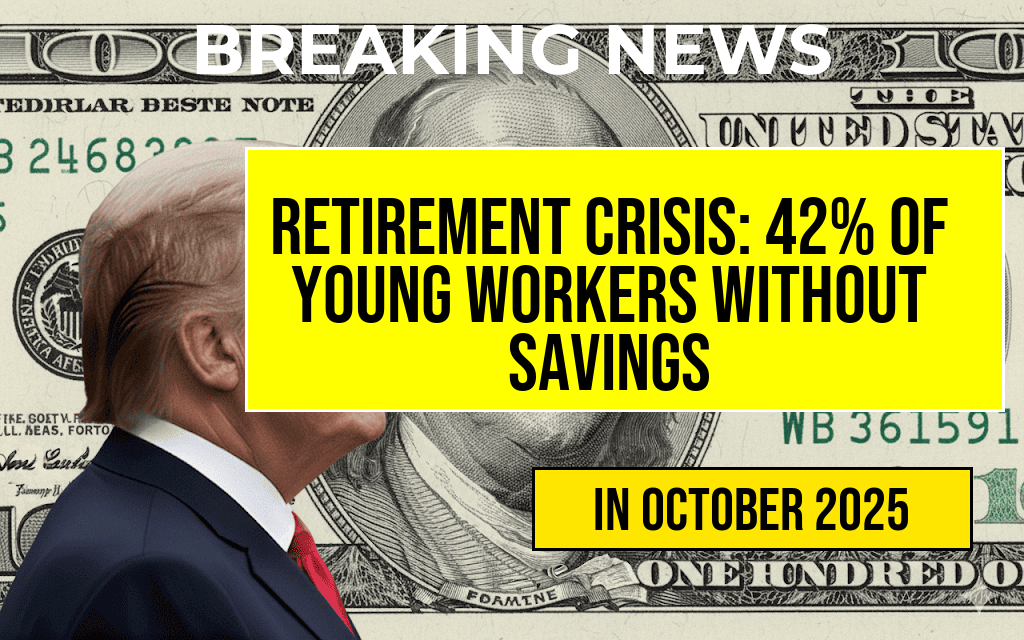Millions of younger workers are confronting a growing retirement savings crisis that experts are calling a “financial vortex.” Recent surveys indicate that approximately 42% of Americans aged 25 to 40 have no immediate savings set aside beyond their regular income, leaving many ill-prepared for the financial demands of retirement. This alarming statistic underscores widespread financial insecurity, compounded by rising living costs, stagnant wages, and insufficient retirement plan participation. As the gap between savings and future needs widens, policymakers and financial advisors are sounding the alarm on the long-term implications of this trend, which threatens to leave a substantial portion of the workforce financially vulnerable in later years.
The Scope of the Retirement Savings Shortfall
Understanding the Numbers
| Age Group | Percentage with No Extra Cash | Average Retirement Savings |
|---|---|---|
| 25-40 | 42% | $12,000 (median) |
| 41-55 | 25% | $45,000 (median) |
Recent data from the Employee Benefit Research Institute (EBRI) reveals that nearly half of young adults are not contributing enough, or at all, to their retirement accounts. The median savings for this group hovers around $12,000, a figure that falls significantly short of the estimated $1 million needed to secure a comfortable retirement, according to [Fidelity Investments](https://www.fidelity.com/learning-center/retirement/retirement-savings). The lack of substantial savings at an early stage can have compounding effects, making it increasingly difficult to catch up later in life.
Factors Contributing to the Crisis
Economic Challenges and Changing Work Dynamics
- Stagnant Wages: Despite rising living costs, wages for many young workers have remained relatively stagnant over the past decade, limiting their ability to save.
- High Student Debt: With student loan debt reaching a record $1.75 trillion, many young adults allocate a significant portion of their income to debt repayment rather than savings.
- Limited Access to Employer-Sponsored Plans: Not all full-time employees have access to or participate in employer-sponsored retirement plans, especially gig and part-time workers.
- Financial Literacy Gaps: A lack of comprehensive financial education contributes to poor planning and low engagement with retirement savings options.
Behavioral and Cultural Factors
Many young workers prioritize immediate financial needs over long-term planning, often perceiving retirement as a distant concern. This mindset is reinforced by a cultural shift emphasizing short-term gratification, further hindering proactive savings behavior.
Implications of the “Financial Vortex”
Long-Term Risks
The ongoing accumulation of insufficient savings threatens to leave a significant portion of the workforce vulnerable in old age. Without adequate retirement funds, individuals may face a reliance on Social Security, which itself is under financial strain and projected to replace only about 40% of pre-retirement income for most beneficiaries, according to the Social Security Administration ([SSA](https://www.ssa.gov)).
Potential Economic Impact
As a large segment of the population enters retirement with minimal savings, there could be increased demand for social services and healthcare support, placing additional pressure on government resources. Moreover, low savings rates among younger adults may ripple into reduced consumer spending, affecting broader economic stability.
Policy Responses and Solutions
Enhancing Retirement Savings Programs
- Automatic Enrollment: Employers are increasingly adopting automatic enrollment features in 401(k) plans to boost participation.
- Incentives for Saving: Tax credits and matching contributions can motivate higher savings rates among low- and middle-income workers.
- Financial Education: Expanding access to financial literacy programs helps individuals make informed decisions about their retirement planning.
Innovative Approaches
Some policymakers advocate for innovative solutions such as state-sponsored retirement savings programs, similar to California’s CalSavers, which automatically enrolls workers in retirement plans unless they opt out. Additionally, integrating retirement planning into broader financial wellness initiatives can address behavioral barriers to saving.
The Road Ahead
Addressing the retirement savings crisis requires a multifaceted approach that combines policy reforms, employer engagement, and individual financial literacy. As experts warn that the “financial vortex” threatens to entrap a significant portion of the younger workforce, stakeholders must act decisively to implement sustainable solutions. Building a culture of savings early in life remains critical to reversing this trend and ensuring economic security for future retirees. For more insights on retirement planning strategies and policy developments, consult resources like [Investopedia](https://www.investopedia.com/) and [U.S. News & World Report](https://money.usnews.com/).
Frequently Asked Questions
What is the main issue highlighted in the article regarding retirement savings?
The article discusses a retirement savings crisis where a significant portion of younger workers, specifically 42 percent, have no extra cash to save for their future, leading to concerns about their financial stability in retirement.
Why are younger workers particularly affected by the Financial Vortex?
The Financial Vortex refers to the cycle of financial challenges that trap many younger workers, including low savings, high debt, and limited income, which hinder their ability to contribute to retirement funds.
How does the lack of extra cash impact long-term retirement planning?
Without extra cash, younger workers are unable to make adequate retirement contributions, increasing the risk of inadequate savings and financial insecurity during their retirement years.
What are potential solutions for young workers to improve their retirement savings?
Potential solutions include increasing financial literacy, seeking employer retirement plans, automating savings, and creating personalized budget plans to prioritize retirement contributions.
What role can employers and policymakers play in addressing the retirement savings crisis?
Employers and policymakers can support by offering accessible retirement plans, incentivizing savings, and implementing financial education programs to help younger workers overcome financial barriers and build adequate retirement funds.






